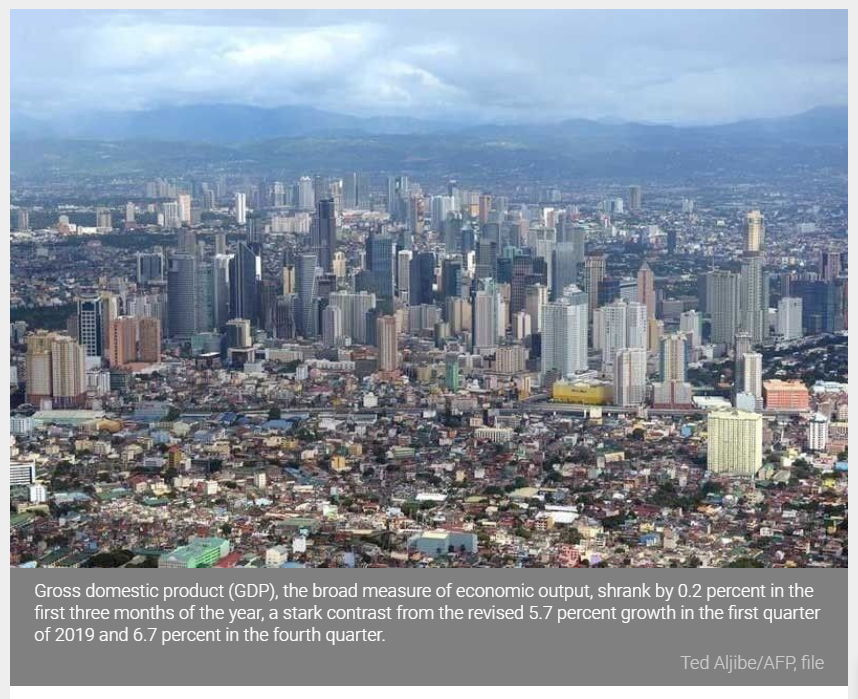Philippines: Economy shrinks by 0.2% in Q1
First time in over 2 decades
MANILA, Philippines — Multiple economic shocks at the start of the year weakened the Philippine economy in the first quarter, as it posted its worst performance since the Asian financial crisis in 1998, the Philippine Statistics Authority (PSA) reported yesterday.
Gross domestic product (GDP), the broad measure of economic output, shrank by 0.2 percent in the first three months of the year, a stark contrast from the revised 5.7 percent growth in the first quarter of 2019 and 6.7 percent in the fourth quarter.
It marked the first time the country’s economic output fell into negative territory since the fourth quarter of 1998, when the country grappled with the combined effects of the El Niño weather phenomenon and the Asian financial crisis. It also ended a streak of 84 straight quarters of GDP growth.
Despite coming from a high growth trajectory in the past year, the economy took a beating after it was hit by a succession of unexpected shocks during the quarter, starting with the eruption of Taal Volcano in January; the significant decline in tourist arrivals because of travel restrictions related to the COVID-19 pandemic in February; and the imposition of the Luzon-wide enhanced community quarantine that strictly limited the mobility of people and goods in the country’s main island and economic powerhouse in mid-March.
“COVID-19 has certainly posed serious challenges to the country’s strong growth and development prospects,” said acting Socioeconomic Planning Secretary Karl Chua in a virtual briefing yesterday.
The agriculture and industry sectors contracted by 0.4 percent and three percent, respectively. The decline in farm and fisheries sector was attributed to lower production of palay and fish catch while the contraction in the industry sector was brought about by the decline in manufacturing, construction, as well as the sustained decline in mining and quarrying.
The services sector, which still had the biggest contribution to the economy, still managed to register a 1.4 percent growth in the first quarter although not as robust as the 7. 1 percent growth seen in the same period last year.
Growth in the supply side of the economy during the first three months of the year was pulled down by declines in manufacturing, transportation and storage, as well as accommodation and food service activities, all of which were directly affected by the draconian measures under the community quarantine.
On the demand side, growth was still seen in household consumption although slower in the first quarter. Government spending, meanwhile, grew by 7.1 percent during the first three months of the year.
Chua said the country is now bracing for the worst global recession since 1930.
In April, the International Monetary Fund projected that the global economy may contract by three percent this year, a deeper slump compared with the 1.7 percent decline in the year following the 2008 financial crisis.
“Where we are now could potentially be the worst global recession since the Great Depression of the 1930s,” said Chua.
The economic recovery program in the works will focus on stimulating domestic demand and improving the country’s investment climate,” he said.
“They to the recovery plan is to convince people that it is safe to go out and work and we can get businesses to normalize,” said Chua. “Stimulating domestic demand can begin with ensuring that agricultural production, food manufacturing, and the entire value-chain – including logistics from the farm to the table – are able to operate at the highest possible capacity.”
He noted that this entails a more aggressive testing and isolation for COVID-19, resuming the Build Build Build program, and passing laws on tax reform and easing of foreign investments.
“As we recover, our socioeconomic policies will have to be adaptive and responsive to evolving realities,” said Chua.
He also recognized that the current crisis now makes it imperative to accelerate the transition to a digital economy, hence the need to revamp digital infrastructure.
Despite the weaker-than-expected first quarter growth, Chua still expressed confidence that the government can still work toward a V-shaped recovery – a scenario of rapid growth after a sharp slump – as quarantine rules have been relaxed in two-thirds of the country’s areas, allowing more economic activities to resume.
With progress on the health front, he said there is cause for optimism that growth can begin to recover by the second half of the year.
For now, the government is still retaining the economic growth performance outlook of zero up to minus 0.8 percent this year.
“We will see over the coming months if we need to adapt and be more realistic. But with the progress we are seeing on the health side, there is a strong chance that we will have a good recovery,” said Chua.
Source: https://www.philstar.com/business/2020/05/08/2012476/economy-shrinks-02-q1


 English
English




